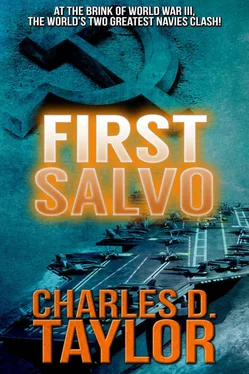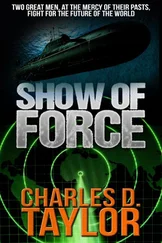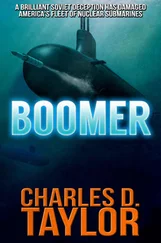As best they could determine, there were four submarines left against two destroyers. Each wolf pack had been hurt. Now the packs were independent, no longer able to present a united front. The initial part of Nelson’s plan had worked.
“Missiles away.” The buzzer echoed the voice, once again indicating that at least one missile was locked on to John Hancock. The source was in the vicinity they had just left. The one remaining submarine persisted! These must be its last missiles, unless the sub could reload tubes under trying conditions faster than Nelson anticipated. If only Hancock could get through this….
Nelson overheard the report of Sea Sparrows launched. He heard the report that they failed to bring down any missiles. Shortly thereafter, he could hear the thump of the automatic five-inch guns vainly pumping shells in the direction of the incoming missiles, hoping for a lucky hit. Then Hancock hummed to the shattering noise of the Phalanx system pumping three thousand rounds per minute at a point the fire-control system determined would intercept the missiles. There were two distinct explosions. One, Nelson was sure, was a hit on a missile. The second followed so quickly that the two were barely distinguishable — except that John Hancock reeled from the impact of one of them. The missile struck to the rear of the ship, perhaps near the aft gun or the Sea Sparrow launcher. It did not penetrate the lower decks of the ship before blowing up, but detonated on impact. The explosions that followed were Sea Sparrow warheads still in their launcher, and a combination of the helo on the flight deck and her torpedoes. The after section of the ship was shattered and fire raged out of control, fed by the fuel in the helo. Yet Hancock continued on her way, her engineering spaces untouched, her steering gear still functioning. Her only defenses were forward — a single five-inch gun, the remaining torpedoes in her ASROC launcher, and her Harpoon missiles which were useful only against a surface ship. She no longer could defend against missiles — her Sea Sparrow and Phalanx systems were destroyed.
There were still submarines ahead. One of the helos had regained contact but no longer had weapons to fire. Nelson sent Briscoe to its aid. Using the helo to pinpoint the approximate location of her contact, Briscoe fired ASROC torpedoes, hoping to home in on the submarine before it went deeper to reload its tubes. They assumed it must have been a stern chase, the submarine running and diving at the same time, but the torpedoes were faster. Sonar soon confirmed a sub breaking up. That left three submarines. The Russians’ undersea attack had been neutralized. Three subs could still fight, but their strategic capability had been destroyed.
Briscoe came back alongside Hancock to assist in the fire fighting. Now Nelson had to make a decision. Should he shift his command to Briscoe ? To the north, Nicholson had three destroyers and three frigates, all with helicopters — a more formidable force than Nelson had started with an hour before. From the position reports, Nelson was positive the Russian strategy had been for both forces to join, probably forming a southern submarine line to act both as decoy and secondary cruise-missile group for the Soviet surface forces as they swept toward Kennedy ’s battle group. Nicholson was experiencing some contact, but the reports seemed to indicate that those submarines intended all along to head south toward a meeting point. If they did not attempt to break through Nicholson’s line, they could also be isolated.
In the end, there was no argument that could keep Nelson aboard John Hancock. The battle was to the north, an hour or so away. His ship could no longer fight a meaningful battle or defend herself. He was the overall commander. His XO could handle the ship. He was highlined to Briscoe to see his part of Pratt’s war through to the end.
ABOARD U.S.S. JOHN F. KENNEDY
Admiral Pratt had seen such attacks before; some had been even more overwhelming than this one. But they had all been simulated. Sometimes NATO prevailed; other times the Russians had won. Some said it was all a matter of throw weight — the explosive power launched at you at a given time. Those who felt the U.S. would always win were absolutely sure it was a matter of tactics — if those tactics were coupled with superior American technology. And there were those few who said these arguments were unnecessary if the enemy were removed from the face of the earth before he could attack.
Dave Pratt knew it was a combination of the first two, plus a dollop of luck. During war games, his computers could destroy his entire battle group if the Soviets were allowed an unlimited number of Backfires. But that would never be the case because, after warning of the initial launch, his own forces would rise to the attack, and the Air Force would set about destroying Soviet air bases and their resupply system.
As he analyzed the development of the attack, Pratt quietly congratulated himself on his initial determination a few weeks before. If he were willing to accept heavy losses at sea, there might definitely be a chance of turning back the crucial land battle for Central Europe.
The nuclear cruiser Arkansas was his next ship to face Soviet missiles, although the number of missiles that might have been targeted for her was much more than ever came close to hitting her. Some were drawn off by the chaff that affected their homing radars, others were decoyed away from the real target. Arkansas brought down at least six of them herself, but there were those that got through. The first dove deep into the bow, the explosion lifting the forward missile launcher out of the deck. When fire threatened the magazine, her captain ordered flooding. The increasing weight of the water began to slow her forward progress. A second missile struck aft just moments later, passing through the hangar deck. The blast damaged the steering gear, and now Arkansas was forced to steer with her engines. Burning fuel threatened the after magazine, and the captain was forced to flood there also. The huge nuclear-powered cruiser was now unable to operate her main battery, the formidable dual missile launchers. She was limited to two automatic five-inch mounts, less firepower than a tiny World War Two escort.
Arthur W. Radford , out on the antisubmarine screen, located the first submarine to break through. Her first warning came through sonar, the scream of approaching high-speed screws. As her captain threw the rudder over in an effort to evade, two torpedoes hit close amidships, about fifty feet apart. The explosions were simultaneous — Radford broke in two. She never had the chance to fire a weapon.
The first hit on Kennedy was on the port quarter, disabling the elevator. The fires there were quickly controlled and might have been insignificant if a second missile had not penetrated the hull on the same side. The flow of water to the fire hoses was instantly cut off. Then the first fire began spreading, igniting a helo poised to go up to the flight deck. Fuel tanks exploded and burning fuel spread to ammunition. In moments, a conflagration shrouded the after section of the hangar deck, and a third missile slammed into the starboard side under the island. With power to the upper levels cut, Dave Pratt found himself in darkness in flag plot. Kennedy was suddenly very alone, unable to monitor the battle outside. Luckily her engine rooms remained untouched, and she was able to continue under her own power. Yet in the real world of electronic warfare, she was proceeding blindly toward the enemy.
Читать дальше












